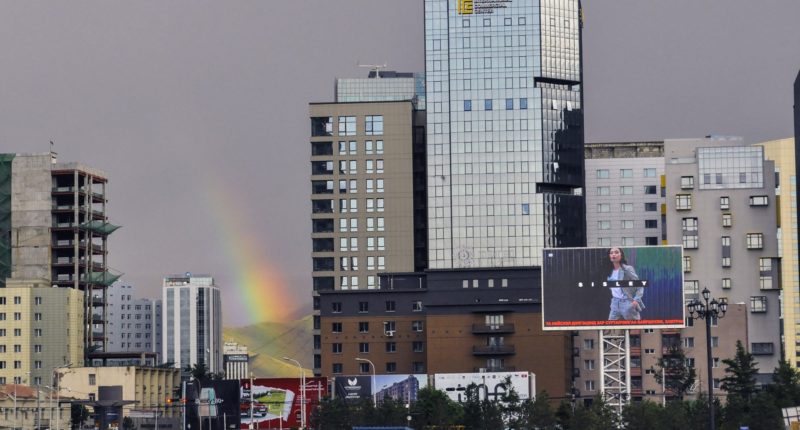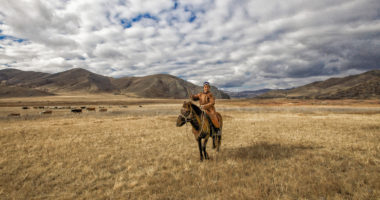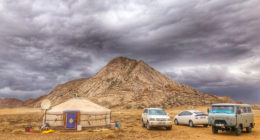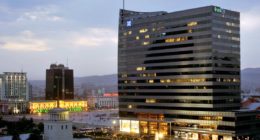Mongolia’s economy has historically revolved around herding and agriculture.
With Soviet assistance, Mongolia established an industrial sector based mainly on mining and the processing of agricultural products. Soviet aid, which accounted for one-third of GDP at its peak, vanished virtually suddenly in 1990-91 as the Soviet Union dismantled, resulting in a severe recession.
In the years 2000-2001 and 2001-2002, severe winter and summer droughts resulted in enormous livestock deaths and weak GDP growth of 1.1 percent in 2000 and 1% in 2001.
From 2004, the Mongolian economy has been growing rapidly, and steadily with the only exception of 2009. In 2002, growth increased to 4%, then 5% in 2003, 10.6% in 2004, 6.2 percent in 2005, and 7.5 percent in 2006. Mongolia saw strong growth rates in 2007 and 2008 due to a mining boom (9.9 percent and 8.9 percent , respectively). Mongolia lost 9.7 million animals, or 22 percent of its entire herd, during the harsh winter of 2009-2010. This had an immediate impact on meat costs, which doubled; GDP fell by 1.6 percent in 2009. Mongolia’s economy began to grow again in 2010, with GDP growing by 7% as the country emerged from its economic crisis.
It was so rapid that in 2011 Mongolia had the fastest growing GDP at 17.3% in the world. However, it did not last long, as at the very peak, there has been a dispute with a major investor, almost instantly changed the course of growth to a decline. Along with other factors such as a decline in international commodity prices and slowing growth in China, the GDP growth fell down to 1.2% by 2016, and by April 2017, the public debt amount neared almost all of the GDP, national bank reserves only equated to 2 months imports and tugrik was devalued by over 20 percent.
At the brink of default on its foreign debts, the government of Mongolia had requested funding from the International Monetary Fund for its Economic Recovery Plan. On May 24, 2017, IMF agreed to provide a three-year Extended Fund Facility program for 434 million USD which was for “stabilize the economy, reduce the fiscal deficit and debt, rebuild foreign exchange reserves, introduce measures to mitigate the boom-bust cycle and promote sustainable and inclusive growth.” This was a part of a larger 5.5 billion financing package led by the International Monetary Fund, with support from the ADB, the World Bank, Korean Government, Japan International Cooperation Agency, and the People’s Bank of China. The Extended Fund Facility program of course imposed conditions and restrictions on the government activities, and set quantitative targets such as Quantitative performance Criteria. In order to boost the potential economic growth prospects, the meeting of QPCs obliged the Government of Mongolian to minimize expenditure and introduce structural reforms.
In 2017, there was a 5.1% percent growth in the economy, which was a far better increase than anticipated, and by the fourth quarter of 2018, it accelerated even further, rising by 6.9% year-over-year. The agreement with the International Monetary Fund, its approval for the Economic Recovery Plan package, the expansion for the largest mine in the country, and the strong export of coal all factored to it.
The mining sector has always been the biggest contributor since the Mongolian Revolution of 1990, and in 2018, it contributed approximately 23.6% of the GDP, while the Agriculture sector is second as always with a contribution of 10.9% of the GDP (in accordance to National Statistics Office). As for Foreign Direct Investment, there was significant growth up until 2011, reaching its peak, at 4.6 billion USD, and since then, its flow had fallen drastically, down to only 94 million USD in 2015. In 2018, the Foreign Direct Investment going into Mongolia increased to 768 million USD thanks to the disputed verdict with the biggest investor and the International Monetary Fund.
After averaging nearly 6% growth from 2017 to 2019, the economy had shrinked in 2020 -2022 due to the COVID-19 pandemic and it is being projected that it will grow at 4.1% in 2024, compared to 7.0% growth in 2023. Growth in 2024 will be supported by mining and higher government spending, though the agriculture sector is expected to contract as Mongolia suffers from one of its worst winters in recent memory.
Contact one of our expert trade advisers to assess your market potential for doing business in Mongolia.









